What do emails and food have in common? More than you’d think, actually. If you run a restaurant, email marketing isn’t just an afterthought — it’s a powerful way to stay connected with your customers, boost reservations, and drive repeat visits.
People still open and engage with emails from businesses they love, which makes it a valuable tool for reaching both loyal patrons and new diners. In this post, we’ll break down how to make restaurant email marketing work for you, share practical strategies, and showcase restaurant email examples that will not only inspire you but might even make you crave your next meal.
Why is restaurant email marketing so crucial?
Email marketing is one of the most effective ways for restaurants to connect with customers, build lasting relationships, and drive more sales. This marketing channel is widely popular among both businesses and consumers, making it a powerful tool for engagement. Small restaurants can start with simple newsletters, but if you want to maximize your impact, email personalization and automation are the keys to success.
Why should restaurant owners care about email automation? Here’s the deal: it lets you set up key email campaigns once and let them run automatically with minimal effort. Instead of manually sending emails every time, your email automation platform does the work for you. And just like that, you keep customers engaged, boost repeat visits, and drive more revenue without lifting a finger.
For instance, you can create a welcome email that automatically launches when a new customer signs up. The system pulls their name from your database and personalizes the message without requiring a marketer to enter each name manually. This is a simple but effective way to automate customer engagement.
Still not convinced that your restaurant needs it? The statistics speak for themselves. According to the TouchBistro State of Restaurants Report, 26% of marketers use email as their primary channel for customer communication, making it the second most popular channel after social media. Among restaurant businesses, 53% already use email marketing automation, while another 42% plan to implement it soon. And it’s not just businesses that rely on email — 41% of consumers aged 18 to 29 prefer email as their main way to stay connected with brands.
How email marketing benefits restaurant businesses
Restaurant email marketing isn’t just about sending messages. It’s a direct line to your customers that can help you turn one-time visitors into loyal patrons and keep your tables full. Here’s how it can help:
- Strengthen customer connections and loyalty. The restaurant industry thrives on creating memorable experiences, and email marketing helps extend that beyond the dining table. Thoughtfully crafted restaurant emails can reinforce your brand, remind customers why they love your establishment, and keep them coming back.
- Promote new menu items, special offers, and locations. If you have something new to offer, email is one of the best ways to spread the word. Instead of waiting for customers to discover your updates on their own, you can send targeted emails to your restaurant mailing list, ensuring your subscribers stay informed and excited about what’s new.
- Increase reservations or delivery orders. If your restaurant offers online booking or delivery, consistent and well-crafted email campaigns can help you attract more customers. For instance, someone might be considering where to book a table, and your latest email highlighting new dishes or a special promotion could be the nudge they need. An automated restaurant email at the right moment can be the final push that turns their consideration into a confirmed booking or order.
- Maximize your marketing budget. Compared to other marketing channels, email is highly cost-effective. While social media requires constant updates and paid promotions, and print advertising can be expensive; email marketing allows you to reach your audience at a fraction of the cost. With an average open rate of 40%, which is 12% higher than the industry average, restaurant emails have a strong chance of driving real engagement and revenue.
Strategies and tips for effective restaurant email marketing
Let’s explore some restaurant email marketing ideas and strategies to implement them.
Build a restaurant mailing list
Successful restaurant email marketing starts with building a high-quality restaurant mailing list — it’s not just about quantity but engagement. Having someone’s email address, however, doesn’t mean you can start sending them messages right away. Consent is essential — customers must opt in and agree to receive your emails.
If you’re collecting email addresses offline, such as through written signup forms, include a section where customers can explicitly give their consent. For online sign-ups, you can use subscription forms with a checkbox requiring users to agree to receive your campaigns before they complete your form.
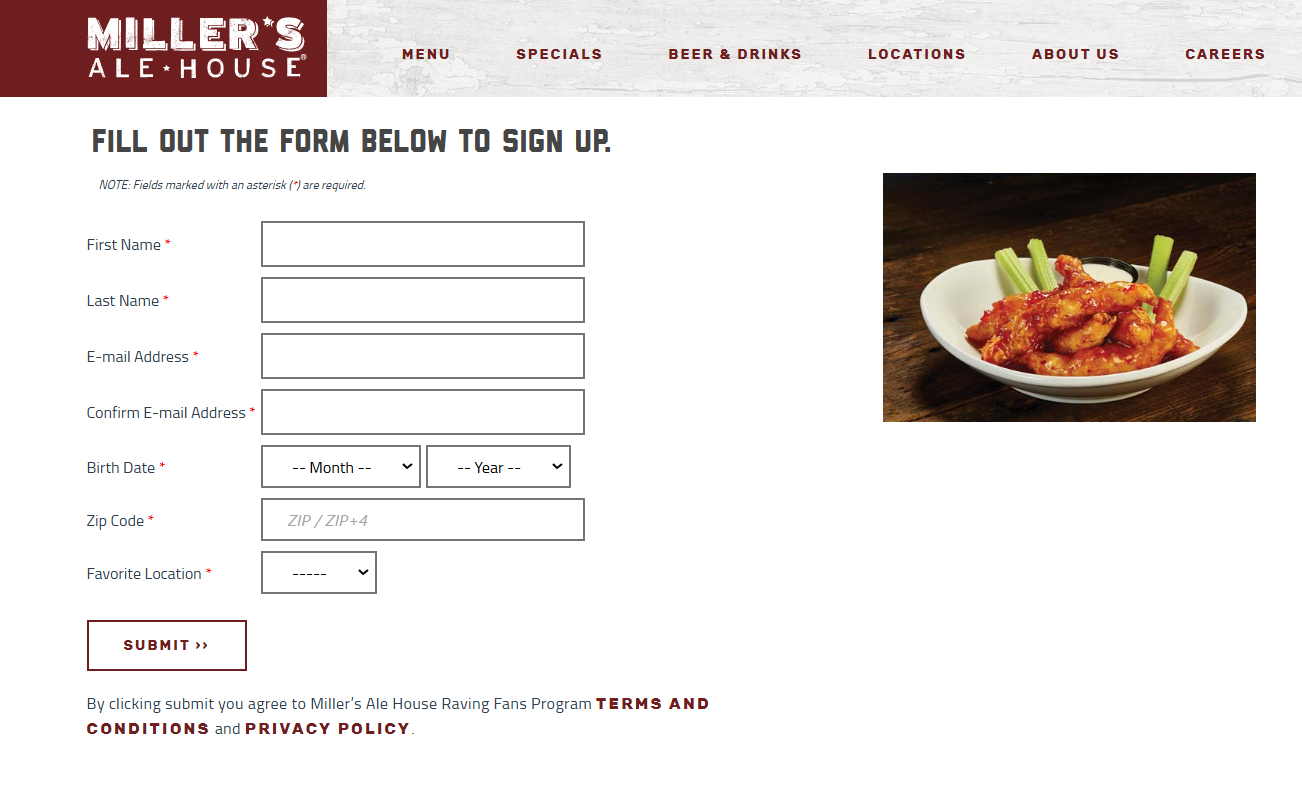 A restaurant collecting email addresses and additional information through a signup form
A restaurant collecting email addresses and additional information through a signup form
Here’s how you can make your contact collection process more effective:
- Use double opt-in for better-quality contacts. This process requires users to not only sign up but also confirm their email via a verification link. Yes, it’s a bit more effort for the subscriber. Yes, some people might drop off due to the extra steps. However, this approach prevents you from collecting invalid email addresses and ensures your restaurant emails go to people who are genuinely interested.
- Give users a compelling reason to subscribe. For instance, your subscribers could get a discount on their first order, early notifications about special promotions or limited-time offers, or VIP access to table reservations. Highlight these perks in your subscription form to boost sign-ups.
- Personalize your pop-ups. Consider the specific characteristics of your potential subscribers. For instance, if you have multiple locations, tailor your bonuses to specific cities. Someone in Madrid likely will not be interested in offers for your London restaurant.
Lastly, keep your restaurant mailing list clean. Regularly remove inactive subscribers, invalid emails, and duplicates. This will improve your email campaign results and prevent wasted marketing spend.
Implement a welcome email sequence
Statistics show that 74% of users expect a welcome email from the brands they subscribe to. These emails are a great opportunity to introduce your company and share your story. For the restaurant business, this is especially important since people often choose establishments based on their atmosphere, not just the food.
Additionally, a welcome email or series can include useful information, such as your restaurant’s operating hours, the number of locations, availability of delivery services, and delivery terms, among other details.
Set up trigger emails
What are trigger emails? These are automated messages sent based on a subscriber’s actions or inactions, meant to keep your restaurant top-of-mind with minimal effort.
What actions could be used to trigger an email? Here are some common scenarios used in restaurant email marketing:
- Table reservation. If a customer reserves a table, send a detailed booking confirmation email, followed by a reminder closer to their scheduled time.
- Delivery order. If a customer places a delivery order, automatically send them an order confirmation email with the details and follow up with tracking updates, estimated delivery time, and courier contact information.
- Browsing the menu. If a visitor browses your menu but doesn’t place an order, send a follow-up email highlighting bestsellers or offering personalized recommendations.
- Abandoned cart. If a customer adds items for delivery or selects a reservation but doesn’t complete the process, send an abandoned cart email. Sweeten the deal with a special offer, like a small discount or a free appetizer, to encourage them to complete their order.
Here’s what an automated order confirmation email looks like:
Trigger emails can also help you re-engage customers who haven’t taken action in a while:
- New subscribers who haven’t ordered yet. If someone signs up but hasn’t made a purchase within a set time (e.g., a month), send a welcome email featuring customer favorites or glowing reviews.
- Lapsed customers. If a once-regular customer hasn’t placed an order in a while (e.g., two months), send them an exclusive special deal, a free delivery offer, or a reminder of their past orders to entice them back.
- Disengaged email recipients. If someone hasn’t opened your restaurant emails for a long time or has ignored multiple campaigns, you can send them a win-back email with a discount or incentive for their next order. Also, give them the option to update their mailing preferences or unsubscribe. This will help you maintain a healthy restaurant mailing list by filtering out inactive contacts.
Make your restaurant emails personal
Personalized emails create a stronger connection with customers and make your offers more relevant. Instead of sending generic promotions, tailor your email campaigns based on the details customers share during sign-up, their browsing activity on your website, past orders, and more.
Customers appreciate emails that feel relevant to them and are more likely to open and act on them. Personalization helps your messages cut through the flood of mass promotions by making customers feel like more than just another name on your mailing list.
One of the best ways to personalize your restaurant emails is to include relevant recommendations. Here’s what restaurant businesses use to tailor their recommendations to customers:
Use AMP and gamification
If you want your subscribers to open your emails with excitement, consider adding gamification elements. Of course, the game shouldn’t exist just for the sake of it. You can tie it to an occasion like a public holiday or a customer’s birthday. Naturally, the game should be enticing, with the promise of an attractive reward as motivation to participate.
For instance, your rewards could include free delivery, a discount, a complimentary dish, a branded gift, or any other incentive that fits your budget and brand. However, if your email simply links to a separate website where customers must enter details to play, participation rates will likely drop.
To keep your email engagement high, you can use AMP technology to let subscribers interact directly within the email. With Accelerated Mobile Pages, you can add interactive elements like forms, carousels, and games right into your email so users can engage without being redirected elsewhere.
For restaurants, this opens up fun opportunities like spin-the-wheel for discounts, scratch cards to reveal prizes, or quick quizzes suggesting menu items based on preferences — all right inside your restaurant email.
And AMP isn’t just for games, it’s also a powerful tool for collecting valuable customer data. This technology allows you to:
- run online surveys to understand customer preferences and offer better recommendations;
- gather feedback about customers’ experiences with your restaurant;
- request evaluations of your online efforts, such as how well your recommendations match their tastes, or how convenient it is to make online orders or reservations.
Another standout feature of AMP is letting customers place orders right from the email. Instead of clicking through multiple pages, customers can browse your menu, select items, and complete their order without ever leaving their inbox. By integrating AMP-powered emails with your ordering system, you can create a seamless, time-saving experience that keeps customers coming back.
Craft stories
Storytelling is one of the most powerful ways to create emotional connections with your audience. Not every restaurant email needs to sell, promote, or push for action. Sometimes, the best emails are simply enjoyable to read. By sharing engaging stories, you can strengthen your brand’s personality and build deeper relationships with your subscribers.
So, what kind of stories work best? Highlight inspiring customer experiences, memorable moments in your restaurant, or behind-the-scenes glimpses of your team. These stories humanize your brand, making it feel more relatable and authentic.
Below are some ideas for storytelling campaigns.
Customer spotlight stories
Share a heartwarming story about a loyal diner or group of regulars who have had memorable experiences at your restaurant. Perhaps a couple celebrated their anniversary with you, or a family made a tradition of dining there every holiday. Highlight how your food or service made their visit special and how it contributed to making those moments unforgettable.
Behind the scenes with your team
Offer a peek into the lives of the chefs, waitstaff, and other team members. Share stories about their passion for food, fun behind-the-scenes moments, or the journey that led them to work at your restaurant. For example, you could feature the story of a chef who came up with a signature dish or a bartender who crafts unique cocktails.
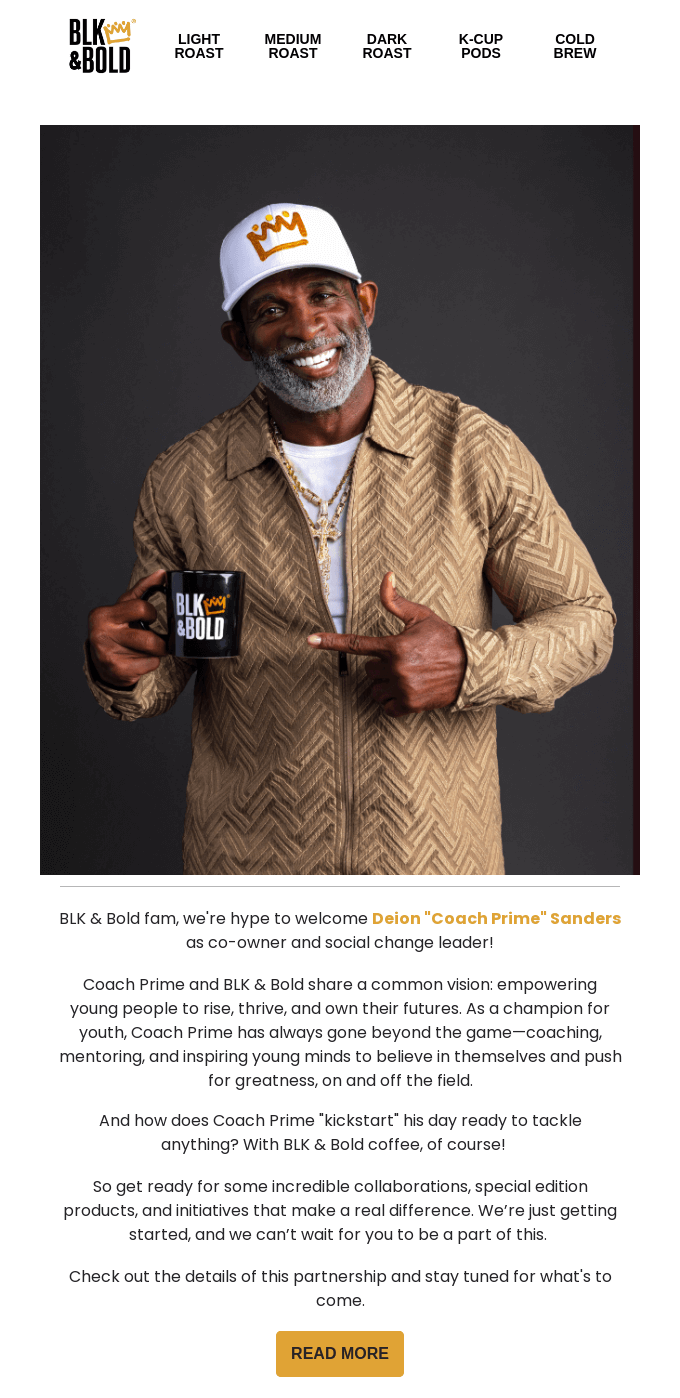 A restaurant email welcoming a new co-owner and social change leader; source: Really Good Emails
A restaurant email welcoming a new co-owner and social change leader; source: Really Good Emails
Throwback stories
Take your subscribers on a nostalgic journey by sharing the history of your restaurant. Maybe it started with a small family kitchen or was once a food truck before finding its current home. Share funny or touching stories about how the restaurant grew and overcame challenges along the way. Add photos from the early days, and let your customers see how far you’ve come.
Seasonal or special occasion celebrations
Send an email celebrating a seasonal change, like the introduction of a new seasonal menu or a special dish inspired by local ingredients. Alternatively, celebrate your restaurant’s anniversary or host a “restaurant family” day where your team shares their favorite dishes. You can even encourage them to share their own memories or traditions connected to your restaurant, reinforcing the sense of community.
Add value
We’ve already talked about emotional stories, orders directly from the email, and fun games. But there’s something else you can incorporate into your newsletters — value for the reader.
In the restaurant industry, this could be recipes, healthy eating tips, advice on dishes, holiday table suggestions, or even a calendar with reasons to have a festive dinner. It all depends on your imagination, the uniqueness of your business, and the services you offer.
Here are three restaurant email ideas that focus on providing value to your audience:
- Healthy recipe ideas from the chef. Share exclusive, healthy recipes from your restaurant’s head chef that subscribers can recreate at home. You could focus on seasonal ingredients, offer lighter alternatives to popular dishes, or showcase your signature dishes with a healthier twist. Including tips on how to make the dishes at home or pair them with the right drinks could add even more value for your readers.
- Holiday table inspiration and menu suggestions. Send out an email with festive meal ideas or a special menu for upcoming holidays or celebrations. Include recommendations for appetizers, mains, and desserts, and offer tips on how to design a beautiful and inviting holiday table. If you offer catering or special event packages, this is also a great opportunity to remind your audience of those services.
- Nutrition tips and meal pairing advice. Offer your audience expert advice on how to make healthier dining choices without compromising flavor. Include meal pairings and explain the benefits of certain ingredients. This can be especially valuable for those who are health-conscious but still want to enjoy a good meal out.
Encourage loyal customers
If you personalize your newsletters, offer tailored recommendations, and provide value to your subscribers, you can further strengthen the connection with your customers. Implement a loyalty program and notify clients of their important achievements through emails. In your emails, you can invite subscribers to join this program, share important news and offers, and celebrate loyal customers’ milestones with pleasant bonuses or gifts.
Here are a few restaurant email ideas for enhancing your loyalty program:
- Exclusive member-only discounts. Send emails to loyalty program members offering special discounts or deals that are only available to them. These can be time-limited offers, such as a discount on their next visit or a free dessert when they reach a certain spending threshold.
- Birthday or anniversary surprises. Send personalized emails celebrating your customers’ birthdays or the anniversary of their first visit to your restaurant. Include a special gift, like a free appetizer or dessert, or a special offer they can redeem on their special day.
- Exclusive early access to new menu items or events. Reward loyal customers by giving them early access to new menu items, seasonal specials, or exclusive events. Send them an email announcing the launch before it’s available to the general public, making them feel like VIPs who get first dibs.
- Referral program incentives. Encourage existing loyalty program members to refer friends or family by offering additional points or rewards for successful referrals. Send out email campaigns explaining how the referral program works, and remind customers that their loyalty benefits not only them but their loved ones too.
- Surprise bonuses for frequent visits. Reward customers who visit frequently with surprise bonuses like a complimentary drink or appetizer after a certain number of visits. Send emails to notify them of their bonus and thank them for their loyalty.
Top 6 restaurant email examples
Let’s take a look at some inspiring restaurant email examples from different brands and the strategies behind them.
Uber
Uber’s email is an excellent example of combining several restaurant email marketing strategies in one campaign. First, the company offers subscribers a bonus to motivate them to place their first order. Their call-to-action stands out in large, bold font, making it the focal point of the email, which ensures that the key message is clear and easy to act on. Also, Uber subtly promotes its Uber One membership by featuring it in the email header, making sure that subscribers see the offer without distracting from the main goal — encouraging them to place their first order.
To increase the chances of a customer ordering, Uber’s email includes personalized dish recommendations featuring items from local restaurants. Promotion details are placed at the bottom in a smaller but clear font to ensure transparency and set the right expectations.
Snackworks
This email is an excellent example of the adding value strategy in restaurant email marketing. Instead of a direct sales pitch, this fast food email provides a curated collection of Thanksgiving recipes, making the content genuinely helpful to subscribers.
At the same time, the company benefits by featuring ingredients it sells, subtly encouraging purchases while building goodwill.
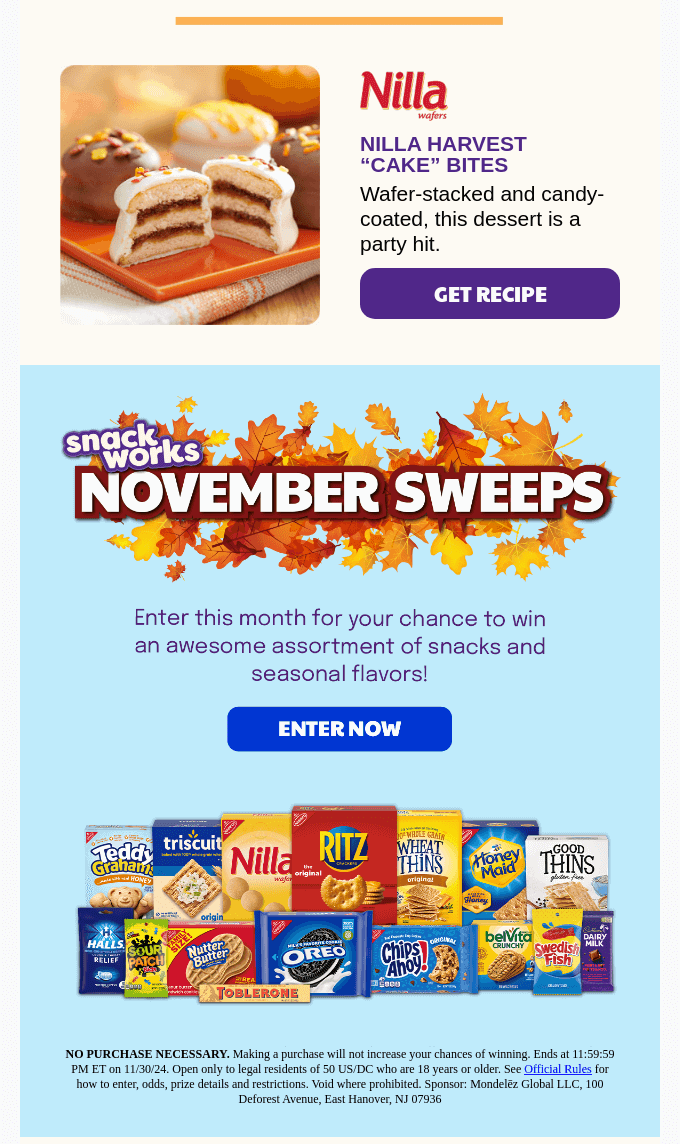 An excerpt of the same fast food email
An excerpt of the same fast food email
Miller’s Ale House
This brand decided to take advantage of the holiday season to introduce its new menu. In the email, they showcase special holiday items and offer the convenience of ordering them online or finding the nearest location. To encourage customers to act quickly, the text emphasizes that this holiday offer is time-limited.
Additionally, Miller’s Ale House included appealing close-up photos of the dishes to tempt customers to try them. To further attract the customer, at the end of the email, they added information about the promotion and its terms.
DoorDash
In this restaurant email, DoorDash keeps it simple and goal-focused by updating customers on their milestone progress. The message highlights that only one more order is needed to unlock a reward, with a progress bar visually reinforcing how close they are to the goal. To drive immediate action, the email features a bright, attention-grabbing CTA button. The email doesn’t contain any recommendations or other offers and focuses entirely on a single goal.
Rosenfeld’s Bagels
This restaurant email example blends storytelling with valuable content. The company shares the tradition of Jewish baking and invites subscribers to watch an expert-led video filled with tips and secrets on perfecting the craft.
Along with providing engaging content, the email subtly promotes the brand’s services. For those who don’t feel like making challah from scratch, ordering fresh, handmade baked goods is just a click away on the company’s website.
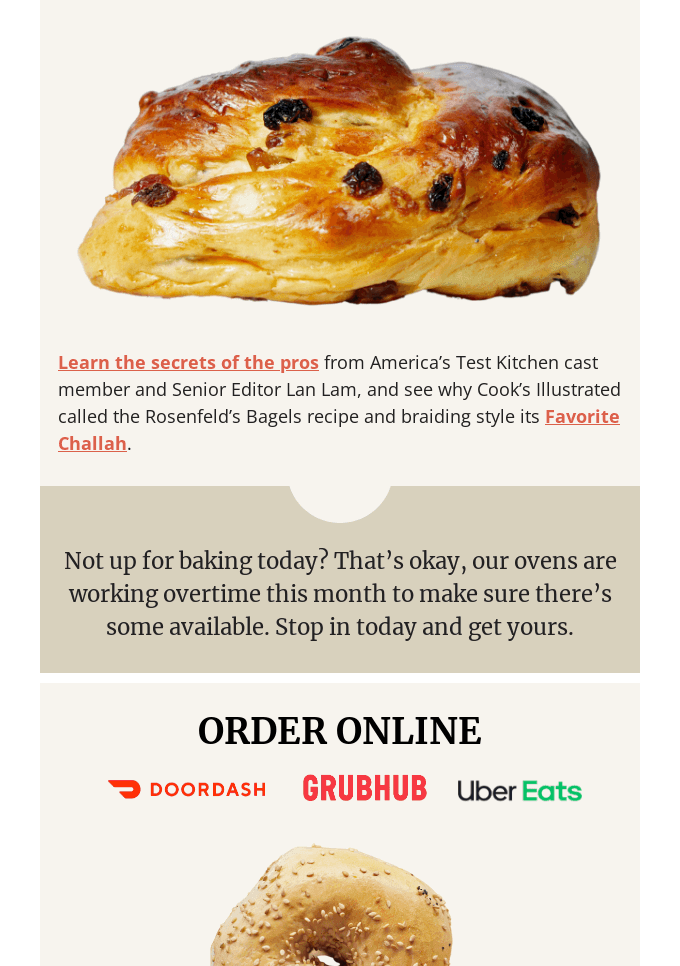 An excerpt of the same restaurant email
An excerpt of the same restaurant email
Levain Bakery
To celebrate the back-to-school season, Levain Bakery launched a special promotion and highlighted it in their email. The message keeps it short and to the point, emphasizing the main incentive — free delivery. The design and wording align with the seasonal theme, ensuring the offer stands out while delivering only the most essential details.
How marketers can use SendPulse for restaurants
To create effective restaurant email marketing campaigns that engage subscribers and deliver the right message at the right time, businesses need the right platform. SendPulse provides all the tools you need to make that happen.
The platform features an intuitive drag-and-drop email editor, allowing you to design restaurant emails effortlessly with your preferred layout and content. Need inspiration or a time-saving solution? SendPulse offers a library of pre-designed restaurant email templates for various occasions, helping you create professional, engaging emails in minutes.
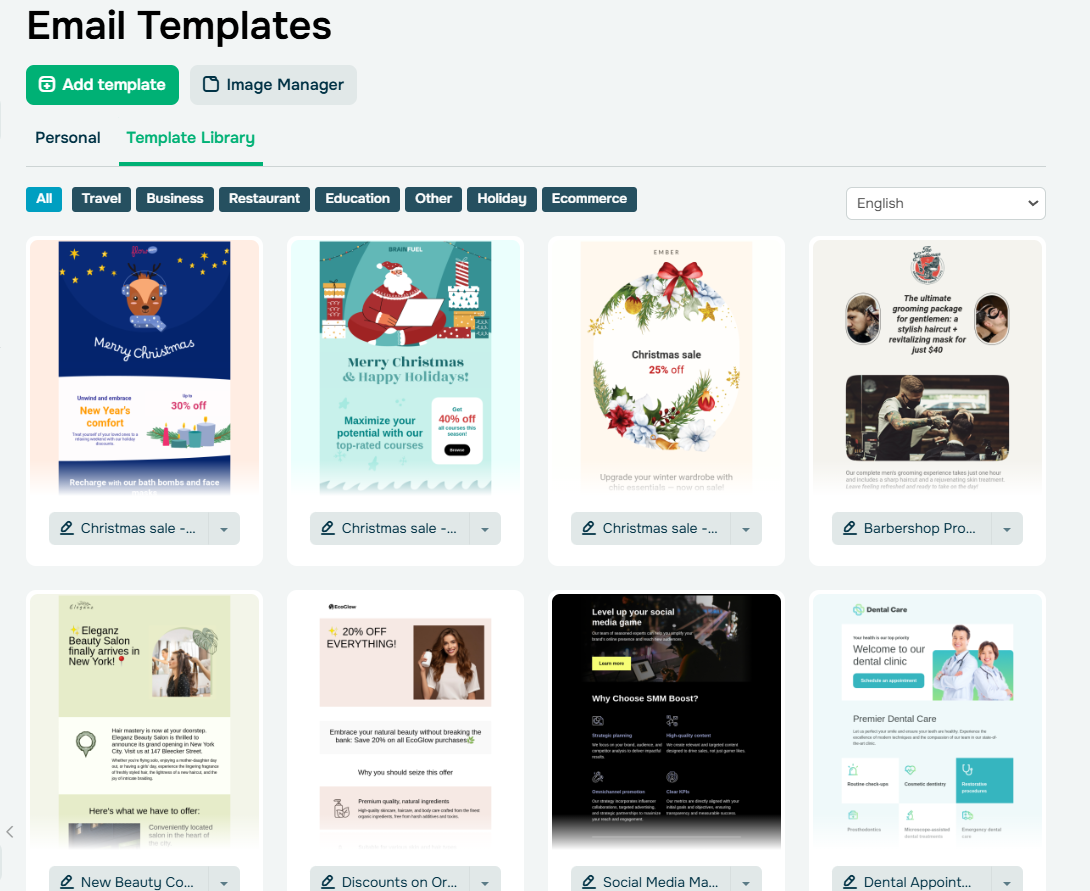 Starting with a template can save you time and resources
Starting with a template can save you time and resources
If you already have a restaurant mailing list, simply upload it to SendPulse. If not, you can create and embed subscription forms on your website to start collecting subscriber contacts immediately.
Once you’ve built your list, marketing automation takes over. Set up welcome email flows for new subscribers, ensuring they receive an engaging introduction to your restaurant. You can also create automated trigger campaigns, such as birthday emails, feedback request, loyalty program updates, or reservation confirmations and reminders.
If you’re struggling with email copy, SendPulse seamlessly integrates OpenAI to help you generate, enhance, or translate your content in seconds.
 Improving email copy with AI
Improving email copy with AI
The AI email assistant allows you to create compelling, on-brand messaging while maintaining efficiency. You can also test different variations to optimize engagement.
To sum up
When building a quality customer base and promoting a restaurant, using a reliable marketing platform is essential. An all-in-one solution like SendPulse will allow you to store contacts in a built-in CRM system, create subscription forms, and launch email, chatbot, and SMS campaigns without needing multiple integrations.
Best of all, these and other helpful tools are included in SendPulse’s free plan, so you can get started without any cost. Give it a try today!